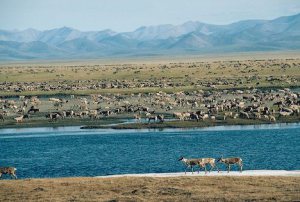Jessica Neves, Animal Science
Adam D’Agostino, Natural Resources and Conservation
Alicia Zolondick, Plant, Soil, and Insect Sciences
Introduction to Genetically Modified Organisms

When examining population ecology, a common story comes to mind. Imagine a habitat with endless resources, and no predation or competition. It sounds like this would be ideal for sustaining population. What could possibly go wrong? This type of environment is the perfect breeding ground for the overpopulation of any species. If a population has enough food to sustain and thrive, exponential breeding will occur. For several generations this growth will not be a significant problem. However, soon there won’t be enough food to sustain the entire population. Food becomes scarce, and individuals begin to compete for limited resources. Only the most fit of the individuals will survive, while the weak will die off due to disease and starvation. The population will plummet drastically, leaving only several individuals left. This cycle is related to the carrying capacity of a species, which is the size of the population that can be sustained indefinitely. By exceeding this limit, the clock starts to tick until disaster strikes.
Just as in the scenario above, the human population will continue to grow when resources allow. Genetically modifying crops became the solution to prolong human existence beyond our carrying capacity. Once the carrying capacity is reached, humans will outnumber the resources available and drastic changes in population will occur. To prevent a collapse in population, humans are doing their best to provide enough food for all to survive by developing genetic modified crops. It is established that genetically modified (GM) crops impact the environment, but are we willing to overlook that in order to save our own? GM crops are necessary to sustain life and increase the carrying capacity of the human population, so we can not foresee eliminating them. Therefore, our plan is to reduce the impact of GM products on the environment, rather than abolish genetic engineering completely.
The World Health Organization defines genetically modified organisms (GMOs) as “organisms (i.e. plants, animals or microorganisms) in which the genetic material (DNA) has been altered in a way that does not occur naturally by mating and/or natural recombination” (World Health Organization [WHO], 2016). GM crops are becoming more and more prevalent in our everyday lives. In the past 30 years, new GM products are available on shelves in supermarkets worldwide. The following paper will discuss the environmental impacts of GM crops and explain how our global society utilizes them in the food system.
Background on the Environmental Impacts of GMOs
Negative impacts on the environment from GMOs are a big concern for scientists and the public. Negative effects on the environment include increased use of herbicides and pollution of aquatic ecosystems. These fundamental issues will comprise the focus of this paper. Given the negative impacts and the need for GMOs for food production, the only way to cope with this dichotomy is to decrease the environmental impact without eliminating modified crops. Preventing these impacts is improbable, but reduction of long term damage to affected ecosystems is plausible and should be attended to by conservationists and genetic engineers collaboratively. There is no one solution to the problem, but there are several practical strategies to limit environmental damage due to GMOs.
Glyphosate Impact
Managing weeds is one of the most tedious tasks of farming. Recognizing the struggles that farmers face with weed management, scientists developed genetically modified herbicide-tolerant (HT) crops so farmers can spray their fields with weed killers without affecting their crop yield. In the past 30 years, developing herbicide tolerant crops (such as corn, soybean, and cotton) has been the most notable advancement in crop engineering history (Bonny 2016). Most of the HT crops are tolerant to glyphosate, a compound used in Roundup to kill many species of weeds that compete with crops.
Glyphosate-tolerant (GT) crops were first developed by Monsanto in 1994. Since GT crops were brought to market, glyphosate-based herbicides (like Roundup) dominated the market and GT soybean, corn, and cotton are the majority of cultivated varieties in global agriculture (Bonny 2016). In 2012, it was calculated that glyphosate made up “about 30% of the global herbicide market, far ahead of other herbicides. (…) For example, for soybean, the glyphosate proportion of total herbicides used grew from 4 % in the 1990-1993 to 89 % in 2006” (Bonny, 2016, p.35). Furthermore, Bonny (2016) states “in 2014, GT soybeans represented 50 % of all HT crops and about 80 % of all globally cultivated soybeans” (Bonny, 2016, p.35).
Monsanto was the world’s top provider of both the GT Roundup Ready crops and the Roundup herbicide treatment. In the 1990s and again in 2003, Monsanto produced literature ensuring that weeds developing GR was extremely unlikely and urged farmers to increase their use of GT crops and Roundup paired together (Bonny 2016). Meanwhile in 1996, Australian scientists who discovered the first GR weed species contended “it would be prudent to accept that resistance can occur to this highly valuable herbicide and to encourage glyphosate use patterns within integrated strategies that do not impose a strong selection pressure for resistance” (Powles et al. 1998, p.6).
GT crops were developed because they were thought to not only eliminate the burden of weed management for farmers, but also reduce the overall amount of herbicides sprayed. GT crops served the farmers well and reduced the amount of time and money spent on hand weeding. However, since the widespread adoption of glyphosate herbicides sprayed on GT crops, the weeds targeted by glyphosate-based herbicides started to develop a resistance to these herbicides (Bonny 2016). The more glyphosate resistance (GR) develops in weed populations, the less effective glyphosate-based herbicides become (Bonny 2016). When herbicides are continually sprayed, there is a high selective pressure on the weed populations. Resistant populations arise from random mutations within individuals that happen to survive the herbicide treatments. When glyphosate is used at a higher frequency than other herbicides, the chance of mutant weed survival to glyphosate is more frequent (Bonny 2016). In other words, the more you spray glyphosate, the more likely it is that the weeds will evolve to survive glyphosate treatment.
Due to the frequency of GT crops, glyphosate herbicides became the sole dominator of the market. As a result, there was an initial decrease in the frequency of general herbicide use. Glyphosate was at first considered a low-risk herbicide for both human consumption and environmental impact, so this decrease was very well received by the public and scientific communities (Bonny 2016). However, this decrease was closely followed by a plateau and then a steady increase in glyphosate applications. It is believed that there is a direct correlation between the decrease in availability of alternate herbicides and an increase in GR weeds. Nearly half of the GR weeds found globally are flourishing on US soil, and burdening farmers with weeds that continued to compete with their crops even when drenching their fields with Roundup.
The graph below was produced by Bonny (2016) based on statistics found from USDA-NASS (1991-2013) and from Heap (2015). This image displays several different herbicides applied to soybeans in the USA in relation to the development and growth of glyphosate-resistant weeds from 1990-2012. The right axis is displaying the number of GR weeds, the left axis is displaying the number of herbicides, and the bottom axis is displaying time. Bonny (2016) states that there was only one survey reporting herbicide usage from 2006-2012. The increased use of herbicides from 2006-2012 based on the numbers from the survey is expressed with the dotted line in the image.
The development of GM Roundup Ready (RR) crops triggered a steady increase in the use of glyphosate (Szekacs & Darvas, 2012). The increased amount of spraying due to GR weeds leads to a higher amount of glyphosate found in our groundwater, surface water, soils, and precipitation (Coupe et al. 2012; Battaglin et al. 2014). The glyphosate can pollute through runoff, pesticide-drift, and leaching through the ground. Research of Mexican water sources by Ruiz-Toledo, Castro, Rivero-Perez, Bello Mendoza and Sanchez (2014), found traces of glyphosate in all tested sources. Sampling sites included irrigation channels, wells, and points along a river bank, providing diversity of water sources (Ruiz-Toledo et al., 2014). The tests found traces of glyphosate in all samples, including tests within natural protected areas (Ruiz-Toledo et al., 2014). The test results prove that glyphosate found its way into water sources through surface runoff, leaching, pesticide-drift, or potentially other modes of transport.
Glyphosate is a water-soluble compound, meaning that glyphosate dissolves in water creating a solution (Szekacs & Darvas, 2012). Glyphosate supposedly decomposes quickly in water, with a relatively short half-life, however it also binds with soils resulting in much longer half-life (Szekacs & Darvas, 2012). Water quality problems arise when glyphosate absorbs into the soil because the chemical leaches or is carried away by runoff.
The concentration of glyphosate in the water source is significantly influenced by the amount of precipitation within the given season, either rainy or dry (Ruiz-Toledo et al., 2014). During a rainy season, the concentration of glyphosate within a water source is diluted, but during a dry season concentrations rise dramatically creating unsafe water quality (Ruiz-Toledo et al., 2014). Amounts of precipitation also determine how far polluted runoff can reach geographically speaking. These changes in precipitation levels cause glyphosate to travel far away from the intended application site. Daouk, De Alencastro, Pfeifer, Grandjean, and Chevre (2013) attribute rainfall to the transport of glyphosate when soils are composed of fine-textured layers on a significant slope. However, Daouk et al. (2013) believe that surface runoff is responsible for the majority of glyphosate transport. With this in mind, Ruiz-Toledo et al. (2014) propose tighter restrictions on proximity of glyphosate application sites to water sources, such as rivers. Since GM crops are frequently paired with excessive glyphosate use, it is crucial that actions are taken to use glyphosate safely in large scale agriculture systems.
Glyphosate applications in close proximity to rivers is problematic to wildlife populations. A high amount of glyphosate is lethal to amphibians and other organisms. Relyea (2005) suggests that Roundup, a compound designed to kill plants, can cause extremely high rates of mortality to amphibians that could lead to population declines in the natural environment as well as death in laboratory conditions. Relyea (2005) provides the example that after three weeks of exposure, Roundup killed 96–100% of larval amphibians (regardless of soil presence) in their natural environment. Another specific example of the lethal effects of glyphosate provided by Relyea (2005) is that when juvenile anurans (a type of amphibian) were exposed to a direct overspray of Roundup in laboratory containers, Roundup killed 68–86% of the juveniles.
Other organisms besides amphibians are also affected. Tsui and Chu (2003) provide the example that “microalgae and crustaceans were 4–5 folds more sensitive to Roundup toxicity than bacteria and protozoa” (p.1189). The toxicity was mainly due to the extreme decrease in pH of the water surrounding the microalgae and crustaceans after glyphosate acid was added during testing (Tsui & Chu, 2003).
Based on the negative impacts that GMOs inflict on the environment presented in this paper, one might formulate the opinion that GMOs should be discontinued or outlawed. However, as predicted by human population growth specialists, the global human population is predicted to reach 9 billion by 2050. The question at the forefront of the century is: how are we, as a collective humanity, going to feed the population? According to “PLOS Biology”, “because most of the Earth’s arable land is already in production and what remains is being lost to urbanization, salinization, desertification, and environmental degradation, cropland expansion is not a viable approach to food security” (Ronald, 2014, p.1). Therefore, engineering GM crops to grow in poor quality soils, fight virulent pathogens, and carry protection against pest damage are necessary to sustain the food demands of the rising populous. Over the past 50 years, population grew substantially and the demand for efficient food production increased. GM crop development accelerated immensely in the past 30 years to try and sustain the global demands for food. According to the Department of Plant Pathology and the Genome Center, “in Bangladesh and India, four million tons of rice, enough to feed 30 million people, is lost each year to flooding,” and their team engineered a species of rice with a flood resistant gene (Ronald, 2014, p.2). This flood resistant gene enables more plants to survive floods, and more people are subsequently able to eat the plants. In our current food system in the Unites States, 80% of food contains derivatives from genetically engineered crops. (Ronald, 2014). The food market is already reliant on GM crop production to feed the people alive right now, and the demand for GM crop production will only increase as the population grows in the future. Certain staple crops like cultivated papayas and bananas would be extinct due to noxious diseases if GM resistant varieties were not developed (Ronald, 2014). Due to the prevalence of GMOs, steps should be taken by growers and plant scientists to ensure that the conservation of the ecosystem and the reduction of negative environmental impact is a top priority. These strategies aiming to balance conservation and technology are a realistic solution instead of abolishing genetic engineering entirely.
Proposal
We propose implementing a plan to change the management practices of using herbicides. Although this plan would not completely reverse the negative impact that GM crops have on the environment, it will be a first step in slowing the total rate of detrimental effects in time. We propose the approval of varieties of GM crops with “stacked herbicide tolerance” (Bonny, 2016, p.40) by the USDA in order to combat the GR weeds. Stacked herbicide tolerance refers to a crop that is engineered to have resistance to multiple herbicides simultaneously. The development of GM crops with stacked herbicide resistance could benefit large scale agriculture because it would allow farmers to spray their fields with multiple different herbicides instead of just glyphosate-based treatments, creating an herbicide management plan. Allowing for variation in herbicide applications would minimize mutant weed resistant populations from developing (Bonny 2016). In addition to encouraging more stacked GM crops, weed scientists should also encourage growers to integrate a wider variety of weed management methods “such as crop rotation, cover crops and mulches, reduced tillage, precision agriculture, adequate seeding rates, seed quality, etc” (Bonny, 2016, p.44). Tsui and Chu (2003) also suggest other alternatives to the original Roundup to use as herbicides. According to Tsui and Chu (2003) “Roundup Biactive was about 14 times less toxic than Roundup” (p. 1196). Using Roundup Bioactive instead of the original Roundup will also hopefully reduce the lethality that this herbicide has on other organisms. Widening the scope of weed management will foster “scientific knowledge in a manner that considers the causes of weed problems rather than reacts to existing weed populations” (Buhler, 2002, p.279). GM crops are necessary to feed the population and will continue to exist, but they can be dangerous to the environment if they are not properly controlled. Changing the management practices of using herbicides will reduce the detrimental effects that many GM crops have on the environment, while simultaneously allowing humans to enjoy their benefits.
References
Battaglin, W.A., Meyer, M.T., Kuivila, K.M., Dietze, J.E. (2014). Glyphosate and its degradation product AMPA occur frequently and widely in US soils, surface water, groundwater, and precipitation. Journal of the American Water Resources Association, 50(2):275–290. doi:10.1111/jawr.12159.
Bonny, S. (2016). Genetically modified herbicide-tolerant crops, weeds, and herbicides: Overview and impact. Journal of Environmental Management, 57, 31-48. doi: http://dx.doi.org/10.1007/s00267-015-0589-7.
Buhler, D. D. (2002). 50th Anniversary, Invited Article: challenges and opportunities for integrated weed management. Weed Science Society of America, 50(3):273–280. doi: http://dx.doi.org/10.1614/0043-1745(2002)050[0273:AIAAOF]2.0.CO;2
Coupe, R.H., Barlow, J.R., Capel, P.D. (2012) Complexity of human and ecosystem interactions in an agricultural landscape. Environmental Development (4):88–104. doi: http://dx.doi.org/10.1016/j.envdev.2012.09
Daouk, S., De Alencastro, L. F., Pfeifer, H., Grandjean, D., & Chevre, N. (2013). The herbicide glyphosate and its metabolite AMPA in the lavaux vineyard area, western switzerland: Proof of widespread export to surface waters. part I: Method validation in different water matrices. Journal of Environmental Science and Health, Part B Pesticides, Food Contaminants and Agricultural Wastes, 48(9), 717-724.
GMO Corn. Digital Image. GMO Corn Crops Under Attack By Leafworms. 2014. 20 Apr 2014.
Heap I (2015) The International Survey of Herbicide Resistant Weeds. http://www.weedscience.org. Accessed 22 July 2015
Powles, S.B., Lorraine-Colwill, D.F., Dellow, J.J., Preston, C. (1998). Evolved resistance to glyphosate in rigid ryegrass (Lolium rigidum) in Australia. Weed Science Society of America 46(5):604–607. doi: http://www. jstor.org/stable/4045968.
Relyea, R. A. (2005). The lethal impact of roundup on aquatic and terrestrial amphibians. Ecological Applications, 15(4), 1118-1124. doi: 10.1890/04-1291
Ronald, P. C. (2014). Lab to farm: Applying research on plant genetics and genomics to crop improvement. Public Library of Science: Biology, 12(6). doi: http://dx.doi.org/10.1371/journal.pbio.1001878.
Ruiz-Toledo, J., Bello-Mendoza, R., Sánchez, D., Castro, R., & Rivero-Pérez, N. (2014). Occurrence of glyphosate in water bodies derived from intensive agriculture in a tropical region of southern mexico. Bulletin of Environmental Contamination and Toxicology, 93(3), 289-293.
Székács, A., & Darvas, B. (2012). Forty years with glyphosate. Herbicides-properties, synthesis and control of weeds. Hasaneen, MN: InTech.
Tsui, M. T. K., & Chu, L. M. (2003). Aquatic toxicity of glyphosate-based formulations: Comparison between different organisms and the effects of environmental factors. Chemosphere Journal, 52(1), 1189-1197. doi: 10.1016/S0045-6535(03)00306-0
USDA-NASS (1991–2013) Agricultural chemical usage, field crops summary. USDA ESMIS (Economics, Statistics and Market Information System), Mann Library, Cornell University, 1990–2013. http://usda.mannlib.cornell.edu/MannUsda/viewDo cumentInfo.do?documentID=1560. Accessed 1 July 2015
World Health Organization. (2016). Frequently asked questions on genetically modified foods. Retrieved from: http://www.who.int/foodsafety/areas_work/food-technology/faq-
genetically-modified- food/en/


 natives cherish, but in the late 1990’s, an insect-transmitted virus hit these crops. This virus destroyed the crops all throughout the island: leaving papaya trees wilted and the fruits with ring-shaped spot deformities (Gonsalves , Tripathi, Carr, & Suzuki, 2010). The ringspot virus was persistent and, despite the farmers’ efforts to rid the virus and save the crops, no solution worked to help the papayas. The infection forced farmers to cut down papaya trees, and one farmer, Ross Subiaco, stated “by the end of six months, [their farm] had only 20 percent of [their] papayas left” (Hirsh, 2013, p.1). After trying selective breeding, quarantine, crop rotation, and anything else imaginable (Saletan, 2015), the Hawaiian farmers decided to try something new – genetically engineered (GE) seeds that were resistant to this specific virus. For this new proposal, the farmers teamed up with scientists to transfer the innocuous coat protein from the ringspot virus to the papaya’s DNA, resulting in an immunity to the virus (Saletan, 2015). This genetically engineered seed was successful and ultimately saved the industry.
natives cherish, but in the late 1990’s, an insect-transmitted virus hit these crops. This virus destroyed the crops all throughout the island: leaving papaya trees wilted and the fruits with ring-shaped spot deformities (Gonsalves , Tripathi, Carr, & Suzuki, 2010). The ringspot virus was persistent and, despite the farmers’ efforts to rid the virus and save the crops, no solution worked to help the papayas. The infection forced farmers to cut down papaya trees, and one farmer, Ross Subiaco, stated “by the end of six months, [their farm] had only 20 percent of [their] papayas left” (Hirsh, 2013, p.1). After trying selective breeding, quarantine, crop rotation, and anything else imaginable (Saletan, 2015), the Hawaiian farmers decided to try something new – genetically engineered (GE) seeds that were resistant to this specific virus. For this new proposal, the farmers teamed up with scientists to transfer the innocuous coat protein from the ringspot virus to the papaya’s DNA, resulting in an immunity to the virus (Saletan, 2015). This genetically engineered seed was successful and ultimately saved the industry.
